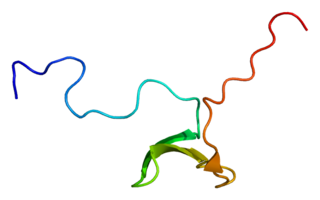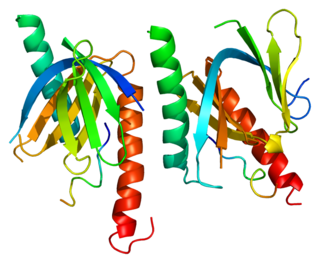Calsenilin is a protein that in humans is encoded by the KCNIP3 gene. [4] [5] [6]
Calsenilin is a protein that in humans is encoded by the KCNIP3 gene. [4] [5] [6]
This gene encodes a member of the family of voltage-gated potassium (Kv) channel-interacting proteins, which belong to the neuronal calcium sensor family of proteins. [7] [8] Members of this family are small calcium binding proteins containing EF-hand-like domains. They are integral subunit components of native Kv4 channel complexes that may regulate A-type currents, and hence neuronal excitability, in response to changes in intracellular calcium. The encoded protein also functions as a calcium-regulated transcriptional repressor, and interacts with presenilins. In addition, the protein has been shown to transcriptionally repress A20 (TNFAIP3) expression and thus modulate the anti-inflammatory signaling. [9] Alternatively spliced transcript variants encoding different isoforms have been described. [6]
Calsenilin has been shown to interact with PSEN1 [4] [10] and PSEN2. [4] [11]

Hippocalcin is a protein that in humans is encoded by the HPCA gene.
Neuronal Calcium Sensor is a large family of proteins which work as calcium dependent molecular switches and includes members like Frequenin (NCS1), recoverin, GCAP, neurocalcin, visinin etc. All the members carry 4 EF hand motifs and an N-myristoyl group.
Delta-1-catenin and Delta-2-catenin are members of a subfamily of proteins with ten Armadillo-repeats. Delta-2-catenin is expressed in the brain where it is important for normal cognitive development. Like beta-catenin and gamma-catenin, delta-catenins seem to interact with Presenilins. These catenin-presenilin interaction have implications for cadherin function and regulation of cell-to-cell adhesion.

Presenilin-1(PS-1) is a presenilin protein that in humans is encoded by the PSEN1 gene. Presenilin-1 is one of the four core proteins in the gamma secretase complex, which is considered to play an important role in generation of amyloid beta (Aβ) from amyloid-beta precursor protein (APP). Accumulation of amyloid beta is associated with the onset of Alzheimer's disease.

Presenilin-2 is a protein that is encoded by the PSEN2 gene.

Myocyte-specific enhancer factor 2A is a protein that in humans is encoded by the MEF2A gene. MEF2A is a transcription factor in the Mef2 family. In humans it is located on chromosome 15q26. Certain mutations in MEF2A cause an autosomal dominant form of coronary artery disease and myocardial infarction.

Amyloid beta A4 precursor protein-binding family B member 1 is a protein that in humans is encoded by the APBB1 gene.

Glutamate ionotropic receptor AMPA type subunit 2 is a protein that in humans is encoded by the GRIA2 gene and it is a subunit found in the AMPA receptors.

Amyloid beta A4 precursor protein-binding family A member 1 is a protein that in humans is encoded by the APBA1 gene.

Potassium voltage-gated channel subfamily D member 2 is a protein that in humans is encoded by the KCND2 gene. It contributes to the cardiac transient outward potassium current (Ito1), the main contributing current to the repolarizing phase 1 of the cardiac action potential.

Kv channel-interacting protein 2 also known as KChIP2 is a protein that in humans is encoded by the KCNIP2 gene.

Necdin is a protein that in humans is encoded by the NDN gene.

Voltage-gated potassium channel subunit beta-1 is a protein that in humans is encoded by the KCNAB1 gene.

Dipeptidyl aminopeptidase-like protein 6 is a protein that in humans is encoded by the DPP6 gene.

Kv channel-interacting protein 1 also known as KChIP1 is a protein that in humans is encoded by the KCNIP1 gene.

ELAV-like protein 2 is a protein that in humans is encoded by the ELAVL2 gene.

Potassium voltage-gated channel, Shal-related subfamily, member 1 (KCND1), also known as Kv4.1, is a human gene.

Kv channel-interacting protein 4 is a protein that in humans is encoded by the KCNIP4 gene.

Voltage-dependent calcium channel subunit alpha2delta-2 is a protein that in humans is encoded by the CACNA2D2 gene.
Kv channel interacting proteins are members of a family of voltage-gated potassium (Kv) channel-interacting proteins, which belong to the recoverin branch of the EF-hand superfamily. Members of the KCNIP family are small calcium binding proteins. They all have EF-hand-like domains, and differ from each other in the N-terminus. They are integral subunit components of native Kv4 channel complexes. They may regulate A-type currents, and hence neuronal excitability, in response to changes in intracellular calcium. Alternative splicing results in multiple transcript variant encoding different isoforms.
This article incorporates text from the United States National Library of Medicine, which is in the public domain.